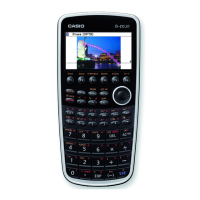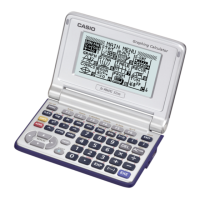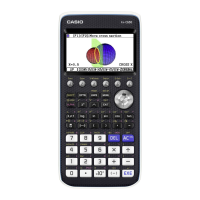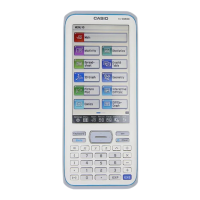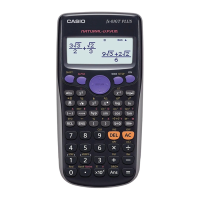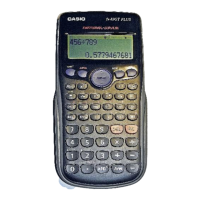2-23
k Fractions
• In the Math input/output mode, the fraction input method is different from that described
below. For fraction input operations in the Math input/output mode, see page 1-13.
• Be sure to specify Comp for Mode in the Setup screen.
Example Operation
2 1 73
–– + 3 –– = ––
5 4 20
= 3.65 (Conversion to decimal)*
1
$2c5e+!$(&) 3e1c4w
<Linear input/output mode>
2$5+3$1$4w
M
1 1
––––– + ––––
2578 4572
= 6.066202547 × 10
–4
*
2
$1c2578e+$1c4572w
<Linear input/output mode>
1$2578+1$4572w
1
––
2
× 0.5 = 0.25*
3
$1c2e*.5w
<Linear input/output mode>
1$2*.5w
*
1
Fractions can be converted to decimal values and vice versa.
*
2
When the total number of characters, including integer, numerator, denominator and delimiter
marks exceeds 10, the fraction is automatically displayed in decimal format.
*
3
Calculations containing both fractions and decimals are calculated in decimal format.
• Pressing the !M(
<
) key toggles the display fraction between mixed fraction and
improper fraction format.
k Engineering Notation Calculations
Input engineering symbols using the engineering notation menu.
• Be sure to specify Comp for Mode in the Setup screen.
Example Operation
999k (kilo) + 25k (kilo)
= 1.024M (mega)
!m(SET UP)ff4(Eng)J999K6(g)6(g)
1(ENG-SYM)6(g)1(k)+251(k)w
9 ÷ 10 = 0.9 = 900m (milli)
= 0.9
9/10w
K6(g)6(g)1(ENG-SYM)6(g)6(g)3(ENG)*
1
= 0.0009k (kilo)
= 0.9
= 900m
3(ENG)*
1
2(ENG)*
2
2(ENG)*
2
*
1
Converts the displayed value to the next higher engineering unit, by shifting the decimal
point three places to the right.
*
2
Converts the displayed value to the next lower engineering unit, by shifting the decimal point
three places to the left.

